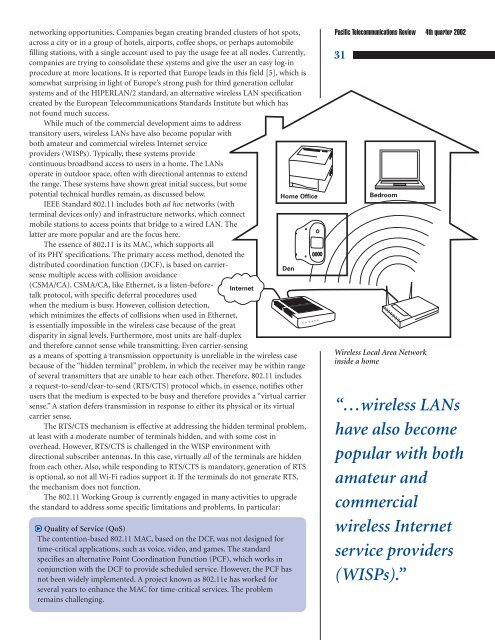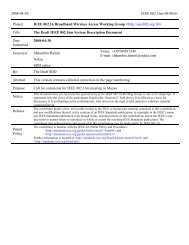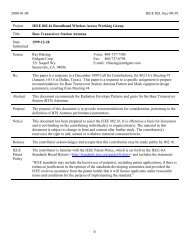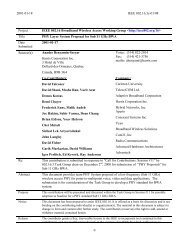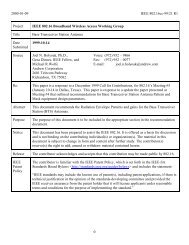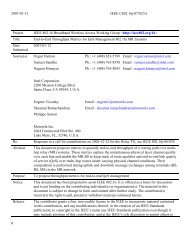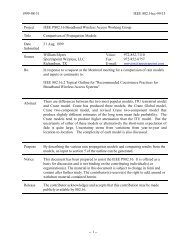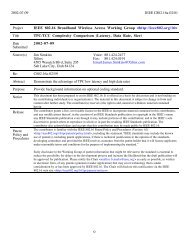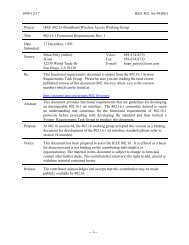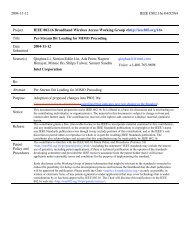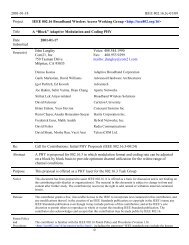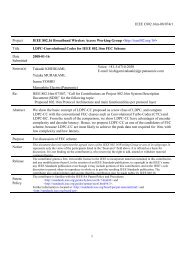Download - LMSC, LAN/MAN Standards Committee
Download - LMSC, LAN/MAN Standards Committee
Download - LMSC, LAN/MAN Standards Committee
You also want an ePaper? Increase the reach of your titles
YUMPU automatically turns print PDFs into web optimized ePapers that Google loves.
networking opportunities. Companies began creating branded clusters of hot spots,<br />
across a city or in a group of hotels, airports, coffee shops, or perhaps automobile<br />
filling stations, with a single account used to pay the usage fee at all nodes. Currently,<br />
companies are trying to consolidate these systems and give the user an easy log-in<br />
procedure at more locations. It is reported that Europe leads in this field [5], which is<br />
somewhat surprising in light of Europe’s strong push for third generation cellular<br />
systems and of the HIPER<strong>LAN</strong>/2 standard, an alternative wireless <strong>LAN</strong> specification<br />
created by the European Telecommunications <strong>Standards</strong> Institute but which has<br />
not found much success.<br />
While much of the commercial development aims to address<br />
transitory users, wireless <strong>LAN</strong>s have also become popular with<br />
both amateur and commercial wireless Internet service<br />
providers (WISPs). Typically, these systems provide<br />
continuous broadband access to users in a home. The <strong>LAN</strong>s<br />
operate in outdoor space, often with directional antennas to extend<br />
the range. These systems have shown great initial success, but some<br />
potential technical hurdles remain, as discussed below.<br />
IEEE Standard 802.11 includes both ad hoc networks (with<br />
terminal devices only) and infrastructure networks, which connect<br />
mobile stations to access points that bridge to a wired <strong>LAN</strong>. The<br />
latter are more popular and are the focus here.<br />
The essence of 802.11 is its MAC, which supports all<br />
of its PHY specifications. The primary access method, denoted the<br />
distributed coordination function (DCF), is based on carriersense<br />
multiple access with collision avoidance<br />
(CSMA/CA). CSMA/CA, like Ethernet, is a listen-beforetalk<br />
protocol, with specific deferral procedures used<br />
when the medium is busy. However, collision detection,<br />
which minimizes the effects of collisions when used in Ethernet,<br />
is essentially impossible in the wireless case because of the great<br />
disparity in signal levels. Furthermore, most units are half-duplex<br />
and therefore cannot sense while transmitting. Even carrier-sensing<br />
Internet<br />
as a means of spotting a transmission opportunity is unreliable in the wireless case<br />
because of the “hidden terminal” problem, in which the receiver may be within range<br />
of several transmitters that are unable to hear each other. Therefore, 802.11 includes<br />
a request-to-send/clear-to-send (RTS/CTS) protocol which, in essence, notifies other<br />
users that the medium is expected to be busy and therefore provides a “virtual carrier<br />
sense.” A station defers transmission in response to either its physical or its virtual<br />
carrier sense.<br />
The RTS/CTS mechanism is effective at addressing the hidden terminal problem,<br />
at least with a moderate number of terminals hidden, and with some cost in<br />
overhead. However, RTS/CTS is challenged in the WISP environment with<br />
directional subscriber antennas. In this case, virtually all of the terminals are hidden<br />
from each other. Also, while responding to RTS/CTS is mandatory, generation of RTS<br />
is optional, so not all Wi-Fi radios support it. If the terminals do not generate RTS,<br />
the mechanism does not function.<br />
The 802.11 Working Group is currently engaged in many activities to upgrade<br />
the standard to address some specific limitations and problems. In particular:<br />
Quality of Service (QoS)<br />
The contention-based 802.11 MAC, based on the DCF, was not designed for<br />
time-critical applications, such as voice, video, and games. The standard<br />
specifies an alternative Point Coordination Function (PCF), which works in<br />
conjunction with the DCF to provide scheduled service. However, the PCF has<br />
not been widely implemented. A project known as 802.11e has worked for<br />
several years to enhance the MAC for time-critical services. The problem<br />
remains challenging.<br />
Home Office<br />
Den<br />
Pacific Telecommunications Review 4th quarter 2002<br />
31<br />
Bedroom<br />
Wireless Local Area Network<br />
inside a home<br />
“…wireless <strong>LAN</strong>s<br />
have also become<br />
popular with both<br />
amateur and<br />
commercial<br />
wireless Internet<br />
service providers<br />
(WISPs).”


